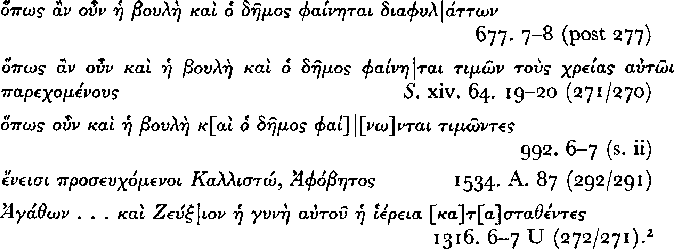No CrossRef data available.
Published online by Cambridge University Press: 11 February 2009
A. Agreement of Participle
(1) Masculine takes precedence over feminine: e.g.

In the first two examples (for which see also II. A. 2 below) the participle may be conceived of as agreeing with the nearer of the two subjects, since it is expressed in the masculine singular. Likewise, refers specifically to
refers specifically to . But the third example, in which the participle is in the masculine plural, clearly demonstrates the usual preference for masculine.
. But the third example, in which the participle is in the masculine plural, clearly demonstrates the usual preference for masculine.
page 242 note 1 This is the. fourth in a series of articles on the language of Attic prose inscriptions, and should have been published before the article which appears in C.Q. n.s. xix (1969) 289 ff.Google Scholar, which is the fifth of the series. For sources used, C.Q.n.s. xiv (1964) 240Google Scholar, n. 2 and n. 5. Note that in the examples quoted all references are to IG ii2, unless otherwise indicated. S prefixed to a reference refers to Supple-mentum Epigraphicum Graecum; H to Hesperia (H.S. ═ Hesperia Supplement). My purpose in the present article is to present additional evidence which Meisterhans (Grammatik der attischen Inschriften 3) does not offer, and in certain cases to modify, or contradict, statements of his.
page 242 note 2 For the tripartite division of the evidence see C.Q. n.s. xvii (1967) 257Google Scholar, n. 2. ‘State’ inscriptions have no sign added to the numbering to denote them; ‘sub-unit’ inscriptions are denoted by ‘U’ written between the line number and the date; ‘private’ inscriptions by‘P’ in the same position.
page 243 note 1 Referred to by Meisterhans, p. 197,§ 82. 5.
page 245 note 1 Cf. in general Meisterhans's account, pp. 222–34,§ 86- In this section I present evidence only where Meisterhans's remarks require expansion or modification.
page 245 note 2 p. 223,§ 86. b.
page 245 note 3 For the rhythm of this pattern see sect. (iii) of my article on Final Clauses, C.Q. n.s. xvi (1966), 295–7.Google Scholar
page 246 note 1 Art. cit., pp. 295–7.
page 246 note 2 Cf. Meisterhans, pp. 222–3.
page 247 note 1 p. 230,§ 86. q.
page 247 note 2 p. 227,§ 86. i.
page 247 note 3 p. 226,§ 86. h.
page 248 note 1 p. 228,§ 86.
page 249 note 1 I am indebted to Prof. K. J. Dover for these references.
page 249 note 2 For parallels see LSJ s.v. τε, C. 10. a.
page 249 note 3 p. 250,§ 91. A. 2.
page 250 note 1 Art. cit., pp. 293–5.
page 252 note 1 For the word-order![]() cf. B. 1. below.
cf. B. 1. below.
page 252 note 2 Present because the proclamation is to be made on more than one occasion![]()
![]()
page 254 note 1 Art. cit., pp. 293–5.
page 255 note 1 cf.Dover, K. J., Greek Word Order, pp. 26ff.Google Scholar
page 257 note 1 C.Q.n.s. xvi (1966), 291–7.Google Scholar
page 257 note 2 Such evidence as I presented for the periods before 323 B.c. and after 146 b.c. was merely offered as a rough point of comparison for the evidence of the Hellenistic period.
page 257 note 3 Contrast Meisterhans, p. 255,§ 91. 33: ‘ὼς άν (mit Konjunktiv und Optativ) ist erst aus der Kaiserzeit zu belegen.’
page 257 note 4 See Meriti, B.D., AJPh lxxxviii. 1 (1967), 29–32Google Scholar